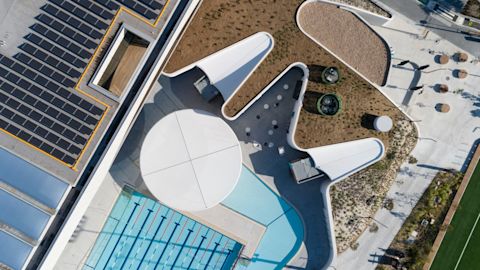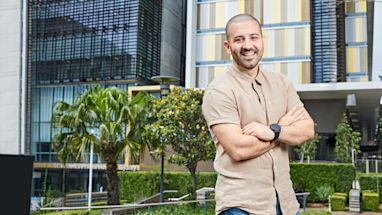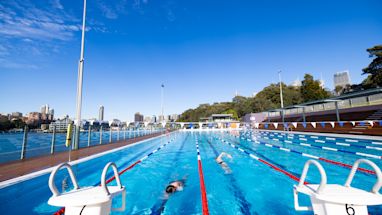
Our world-class Gunyama Park Aquatic and Recreation Centre has taken out a public architecture award at the prestigious Australian Institute of Architects Awards.
Aesthetics, access and renewable design turned Gunyama Park Aquatic and Recreation Centre into a winner at the peer-reviewed national architecture awards.
The jury described it as “playful work that inspires a consideration of how the enjoyment of water-based environments has developed the psyche of an entire culture.”
The centre’s new pool, modelled on Sydney’s iconic beaches, is the biggest built in Sydney since the 2000 Olympic Games.
With lap pools, exercise areas and chillout zones, Gunyama Park is part of our commitment to build sustainable facilities that meet the diverse needs of our communities.
Enjoy a behind-the-scenes glimpse into how different experts brought their designs to life in this stunning complex.
Pools create an urban oasis in Green Square

There is a special kind of pleasure in swimming in ocean rock pools familiar to Sydneysiders. This is the feeling Gunyama Park designers Andrew Burges Architects and Grimshaw with landscape architects Taylor Cullity Lethlean in collaboration with the City of Sydney evoke in their design.
“Our goal was to create a new recreational heart for Green Square. Given the centre’s location in such a new high-density area, it was really important to go beyond just providing lap swimming.
“The beach pools helped inspire this – making places for sitting in the sun reading, for relaxing on the water’s edge on a hot day, for kids to play without getting in the way of serious swimmers – making a community facility that was inclusive and open ended in celebrating the pleasures of swimming and water,” said Andrew Burges.
The designers drew on elements from Bronte, Coogee and Curl Curl beaches to ‘bring the beach’ to Green Square’s urban landscape. Striking new buildings, including our Green Square library and Joynton Avenue creative centre, add to the skyline.
The design celebrates enduring Eora culture on Country

Gunyama Park takes its name from the Aboriginal Sydney language word for ‘wind from the southwest’. The site, where before settlement, fresh and salt water flowed together, was an important area for Eora people.
Ancestral stories have been woven into the design of the centre through the public art and an Indigenous interpretation strategy.
Bangala was made by Gorawarl/Jerrawongarla traditional owner Aunty Julie Freeman and Wiradjuri and Kamilaroi artist Jonathan Jones. The artwork was inspired by the bangala palm water vessels that were used to carry and maintain fresh water in coastal environments. It highlights the continued importance of water on this site.
Marray (or ‘wet’) is an interpretive work which also points to a connection to traditional Country. It places local Dharug and Dharawal words on the edges of the pools and wetland landscaped pathways.
We’re continuing to work with the centre operators and First Nations people in the local area to ensure the centre is welcoming and inclusive. Plans are underway to continue the Indigenous perspective in the next stage of works, which includes a children’s play area and green space.
Form meets function for different needs

Accessibility and inclusion were the centre’s main design priorities. Gunyama Park has a 50-metre outdoor pool set within recreational paddling areas. Bathers can have a rest under the umbrellas, chill on the pool’s ‘shoreline’ or get a coffee at the café. And with a creche at the centre, parents can take a moment to relax or focus on their stroke.
The indoor 25-metre pool has a moveable floor for different activities, from water polo to swimming lessons. For kids there’s a shallow pool for waterplay with slides, spraying jets and a tipping bucket.
All pools have ramp access and a shallow decline. Two pool hoists can be moved to different parts of the centre. There’s also a hydrotherapy pool built to the Australian standard.

Gunyama Park is the first aquatic centre in NSW to have a fully accredited Changing Places facility.
This means the secure changing and toilet facilities meet the needs of people who require space and assistance and where a generic toilet is not suitable.
A hearing augmentation system that covers all areas of the centre, a charging point for mobility scooters and an AccessKey that provides predictive information for people with various needs.
Other exercise facilities include a synthetic sports field, a gym with equipment and classes, a yoga deck and an outdoor training circuit.
High standard of sustainability

City of Sydney green infrastructure implementation manager Chris Collins said Gunyama Park is the first recreation centre in Australia to achieve a 5 Green Star design rating.
“The design gives us flexibility to manage energy consumption. It also makes the centre significantly cheaper to run,” said Chris Collins.
The centre has an energy saving climate control system and 420 photovoltaic panels that generate power. The panels are connected to the City of Sydney’s local electricity network across the road. This means that any extra energy can be used to power buildings in the surrounding precinct.
The centre’s ‘passive design’ means it can maintain comfortable temperatures without the need for excessive heating and cooling. It has natural ventilation, shading and lighting and a roof made from a light-filtering material. Water smart taps, showers and toilets minimise water use.
Published 2 July 2021, updated 8 November 2021



